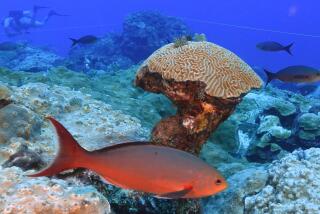Zooming In on Florida’s Wildlife
- Share via
Most people associate Florida with the glitter of Miami Beach, the fantasy and high-tech of the Walt Disney complex or the hedonistic pleasures of the beaches.
We have seen and enjoyed these aspects of Florida, but recently were introduced to another side of that fascinating and complex state. We took a photographic tour of Florida’s zoos, animal sanctuaries, state parks and natural attractions.
These preserves of Florida’s wild life offer the photographer fine opportunities to get close-up pictures of usually unapproachable birds and animals.
Miami is proud of its new Metro Zoo and although it is a bit far from downtown and the beaches, the drive is well worth the time for a photographer.
Like many modern zoos, the animals and birds are displayed in a setting that simulates their natural habitat as much as possible. We took some remarkable shots, with a 70- to 210-millimeter zoom lens, of a pregnant orangutan that looked very much like a college kid who had overindulged in beer and pizza.
Simulated Ruins
The Bengal tigers live on an island amid the simulated ruins of an ancient temple.
Later we crossed the causeway from Miami to Key Biscayne to reach the Seaquarium, one of the original marine-life attractions for Florida visitors. It is also an important marine research center. We met and interviewed Dr. Jesse White, a large bear of a veterinarian who could well be called the James Herriot of manatees.
White explained that the manatee, related to the elephant, inhabits the rivers, estuaries and coastal waters of Florida. The lethargic manatee, looking much like an overstuffed couch, often floats, half asleep, just below the surface of the water and so unfortunately is highly vulnerable to the slashing propeller blades of power boats.
You can see fine manatee specimens in the tanks at the Seaquarium. A polarizing filter is helpful in reducing surface reflections in the water and for getting clear shots of these playful and gregarious vegetarians.
Sea World in Orlando is a highly polished showcase of performing whales and porpoises in addition to marine birds, seals, otters, sea lions, sharks and a multitude of tropical reef fish.
Arrive at the whale and dolphin stadium about 10 minutes before a performance because trainers will frolic with the porpoises just before the show starts.
High Shutter Speed
Outstanding underwater pictures can be taken directly through the large transparent panels along the edge of the tank with through-the-lens metering on either manual or automatic setting. Use a relatively high shutter speed of at least 1/125th of a second to stop the action.
Homosassa Springs is a down-home type of attraction with a wide variety of photogenic birds and animals in natural settings. The real attraction, however, is the famous Fish Bowl Spring that contains thousands of saltwater and freshwater fish in addition to several resident manatees.
They can be photographed from a large underwater observatory sunk into the spring. This is one of the few places where you can photograph a densely packed school of fish as they might appear in the ocean.
Weeki Wachee Springs has a Birds of Prey Show that includes golden eagles, falcons, hawks, African vultures and the bald eagle.
After the show you’ll have an opportunity to take some close-ups of these wild birds with their trainers. We found that a telephoto zoom at about the 200-millimeter extension was ideal for head shots of the birds.
The mermaid show also will delight children, and it is possible to get clear shots from front seats in the underwater theater. (Don’t try flash because it won’t work.)
On the northeast coast in the St. Petersburg area a small, unpretentious facility called the Suncoast Seabird Sanctuary is tucked away between the beach condominiums and resort hotels of Indian Shores. The dedicated staff works with wounded and disabled sea birds in general, but the resident population is largely made up of brown pelicans. Director Ralph Heath will be delighted to show you around and help you get some impressive pelican portraits.
The Dark Continent
It would be a mistake to leave this area of Florida without seeing The Dark Continent of Busch Gardens in Tampa, where you can take a simulation of an African safari. The attraction is stocked with thousands of animals that roam freely.
Visitors enter the veldt by monorail or train, and some can arrange for a photo safari aboard the feeding truck at special times. You’ll want a good telephoto lens in the 200- to 300-millimeter range for some pictures, but in other instances you’ll do very well with a standard 50 millimeter. Adjacent to the veldt are other attractions on the African theme.
Florida can be a truly wild experience and yield some dramatic pictures of birds and animals, both native and imported.
Pack your cameras and go. For information write to Florida Division of Tourism, Bureau of Tourism Publicity, 410 D, Collins Building, Tallahassee, Fla. 32301.
More to Read
Sign up for The Wild
We’ll help you find the best places to hike, bike and run, as well as the perfect silent spots for meditation and yoga.
You may occasionally receive promotional content from the Los Angeles Times.






